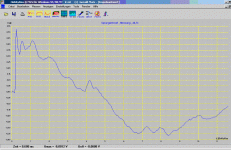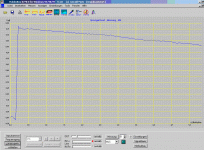I was also trying to move the "hump" to the steep filter branch(i.e. lowpass) but the maths doesn't seem to like this.
Regards
Charles
Regards
Charles
phase_accurate said:The original Manger crossover performs a 180 phase change during the transition, what a subtractive crossover won't do.
Therefore the first zero-crossing of the step response occurs after 700us approx.
I am still puzzled by that statement. The Manger itself (as per Manger spec sheet) has almost 180° phase shift around its resonance. I guess the change is that slow because of the high R_ms of the Manger. A first order high pass above resonance will introduce another 90°. I am currently confused about the sign convention, but I believe it will lower the total shift to 90°, rather than adding to it.
Anyway, in the test of the Zerobox 109 in K&T 5/99, I don't see any evidence of a zero crossing between 0 and 1 ms.
And as Nelson pointed out in his article on phase coherent XOs, if one of the drivers is operating near its resonance, the acoustic signal will not be phase coherent. The only way I see to change this is to use a Linkwitz to correct the Manger to an f_s well below 50 Hz. But then, you will probably need to put the high slope side on the Manger and have the woofer live with the hump and the 6dB slope.
Regards,
Eric
Hi Eric
If you have closer look at the Zerobox 109 datasheet at
http://www.e-speakers.com/PDF's/Manger%20109%20Project.pdf
you will clearly recognize that there is a first zero-crossing after 500us approx and the second one after 4.5 ms.
An optimal transient perfect speaker would only have ONE zero crossing.
The points mentioned by NP are indeed the ones that make the application of a subtractive crossover with the MSW cumbersome.
Although I regard transient response and minimal difference between both speaker's amplitude response the most important things for this project, I do still aim at an amplitude response that is flat within +- 2 dB. And that is where I struggle most at the moment.
As you correctly mentioned, there is indeed the possibility of getting around the problem with a 6 dB slope on the woofer. I do however fear that even the best woofers will introduce some midrange artefacts that will mask/destroy the MSW's excellent midrange clarity.
Regards
Charles
If you have closer look at the Zerobox 109 datasheet at
http://www.e-speakers.com/PDF's/Manger%20109%20Project.pdf
you will clearly recognize that there is a first zero-crossing after 500us approx and the second one after 4.5 ms.
An optimal transient perfect speaker would only have ONE zero crossing.
The points mentioned by NP are indeed the ones that make the application of a subtractive crossover with the MSW cumbersome.
Although I regard transient response and minimal difference between both speaker's amplitude response the most important things for this project, I do still aim at an amplitude response that is flat within +- 2 dB. And that is where I struggle most at the moment.
As you correctly mentioned, there is indeed the possibility of getting around the problem with a 6 dB slope on the woofer. I do however fear that even the best woofers will introduce some midrange artefacts that will mask/destroy the MSW's excellent midrange clarity.
Regards
Charles
OK, I guess I misread the axis captions in K&T (the print is really poor).
I gather this 180° shift is mainly due to the resoance of the MSW, not the filter itself. So how does your subtractive crossover get rid of it without resorting to a Linkwitz transform circuit to move the MSW resonance out of the way?
Regards,
Eric
I gather this 180° shift is mainly due to the resoance of the MSW, not the filter itself. So how does your subtractive crossover get rid of it without resorting to a Linkwitz transform circuit to move the MSW resonance out of the way?
Regards,
Eric
It does not get rid of it.
I do two things:
1.) I have a network that flattens the MSW's response around fs a little.
2.) I have approx 2 dB more gain on the woofer than on the MSW (taking the driver efficiency into account).
This leaves me with a 2 dB dip around 200 Hz. With this dip I could live, but in practice it is more than that unfortunately.
Regards
Charles
I do two things:
1.) I have a network that flattens the MSW's response around fs a little.
2.) I have approx 2 dB more gain on the woofer than on the MSW (taking the driver efficiency into account).
This leaves me with a 2 dB dip around 200 Hz. With this dip I could live, but in practice it is more than that unfortunately.
Regards
Charles
Charles, (phase_accurate),
What Audio Technology drivers are you using with your Manger?
After living with them for a time, would you change the Audio Technology driver to a different size or spec?
Mark
What Audio Technology drivers are you using with your Manger?
After living with them for a time, would you change the Audio Technology driver to a different size or spec?
Mark
G'day Mark
My AT drivers are Flex Unit (i.e. custom made) 8 B 77 25 06 SD.
Many people say that the C-Qequenze drivers were a little better in terms of frequency response than the Flex-Units (and they have a nicer looking basket).
This fact combined with the cheaper price and the fact that I don't need as much x-max as I first assumed (one's listening habits change over time !) I would even go for a C-Quence 23 I 52 ....... which would even be cheaper.
For me the exact TSPs are not that important since I use an LTF (and the aforementioned C-Quence is also quite close to mine BTW).
Regards
Charles
My AT drivers are Flex Unit (i.e. custom made) 8 B 77 25 06 SD.
Many people say that the C-Qequenze drivers were a little better in terms of frequency response than the Flex-Units (and they have a nicer looking basket).
This fact combined with the cheaper price and the fact that I don't need as much x-max as I first assumed (one's listening habits change over time !) I would even go for a C-Quence 23 I 52 ....... which would even be cheaper.
For me the exact TSPs are not that important since I use an LTF (and the aforementioned C-Quence is also quite close to mine BTW).
Regards
Charles
Well, since I am a grass-widower currently our living room has been changed into a speaker-testing lab. I am currently experimenting with a crossover topology that is a variant of this one:
http://www.diyaudio.com/forums/showthread.php?postid=292789#post292789
Attached you can see the in-room measurement of the step-response. You'll have to note that the room is very reverberant, the "echo" at 4ms approx is most probably floor-bounce since it correlates quite well with the path-difference divided by c.
Regards
Charles
http://www.diyaudio.com/forums/showthread.php?postid=292789#post292789
Attached you can see the in-room measurement of the step-response. You'll have to note that the room is very reverberant, the "echo" at 4ms approx is most probably floor-bounce since it correlates quite well with the path-difference divided by c.
Regards
Charles
Attachments
sorry, above link was wrong, it should be:
http://www.diyaudio.com/forums/showthread.php?postid=292070#post292070
Regards
Charles
http://www.diyaudio.com/forums/showthread.php?postid=292070#post292070
Regards
Charles
So many reads since my last post and no one objected !!! Or did everyone notice the date of the posting ?
If I really had a simple analog solution to achieve such a step-response from a multiway system it would make many people workless !
Regards
Charles
P.S. The Step response is form the soundcard alone. 😉
If I really had a simple analog solution to achieve such a step-response from a multiway system it would make many people workless !
Regards
Charles
P.S. The Step response is form the soundcard alone. 😉
Goldmund Leonardo a la analog?
Yes, sort of but it was a joke of course !
I have only seen the white-paper of the Goldmund speaker so far but no measurement so I remain sceptical as to what degree they achieve the ideal.
The best step response I have seen so far was from the Klein + Hummel O500.
Regards
Charles
One of the German forum members once suggested that the MSW could/should be used together with a rear-firing tweeter in order to achieve better polar response.
I once tried it earlier this year by placing a pair of two-way boxes - aimed at the back wall - on the Manger boxes. I ran them with disconnected woofers. The result was quite astounding. Imaging was possible within a larger sweetspot than usual (remeber that Mangers are usually best suited for selfish listeners). But it was definitely less focused. And the sound was overly bright as well. But the experiment told me that the idea is well worth trying.
So I recently made a second attempt by using two NOS D-260 (Dynaudio) that I have in stock. I crossed them quite low at 1.2 kHz with a first order crossover followed by a resistive divider. The current divider has a damping of 10 dB approx.
The listening results tell me that it might be worth considering a rear-firing dome-tweeter with an own smallish amp (with user-adjustable crossover and level control in order to adjust to the environment) in the final active version of the speaker. The rear-fired energy does not have to be very high.
Regards
Charles
I once tried it earlier this year by placing a pair of two-way boxes - aimed at the back wall - on the Manger boxes. I ran them with disconnected woofers. The result was quite astounding. Imaging was possible within a larger sweetspot than usual (remeber that Mangers are usually best suited for selfish listeners). But it was definitely less focused. And the sound was overly bright as well. But the experiment told me that the idea is well worth trying.
So I recently made a second attempt by using two NOS D-260 (Dynaudio) that I have in stock. I crossed them quite low at 1.2 kHz with a first order crossover followed by a resistive divider. The current divider has a damping of 10 dB approx.
The listening results tell me that it might be worth considering a rear-firing dome-tweeter with an own smallish amp (with user-adjustable crossover and level control in order to adjust to the environment) in the final active version of the speaker. The rear-fired energy does not have to be very high.
Regards
Charles
I devised a phase-plug for the Manger that widens HF dispersion noticeably. I posted details here but no-one showed any interest. Give it a search. It might give you what you want without the need for an extra tweeter?
Your thread is this one:
http://www.diyaudio.com/forums/showthread.php?s=&threadid=97865&highlight=
Might not be a bad idea if someone finds an aestetically pleasing method to suspend this phase-plug.
I don't know if the range you are talking of is affected by destructive interference but the Manger IS suffering from such things. The "holes" at 800 Hz and 1.6 kHz are a result of interference.
The advantage of the rear-firing driver is the possibility to make it adjustable.
Regards
Charles
http://www.diyaudio.com/forums/showthread.php?s=&threadid=97865&highlight=
Might not be a bad idea if someone finds an aestetically pleasing method to suspend this phase-plug.
I don't know if the range you are talking of is affected by destructive interference but the Manger IS suffering from such things. The "holes" at 800 Hz and 1.6 kHz are a result of interference.
The advantage of the rear-firing driver is the possibility to make it adjustable.
Regards
Charles
phase_accurate said:
Might not be a bad idea if someone finds an aestetically pleasing method to suspend this phase-plug.
Attachments
Manger do have a transparent deflector/diffuser/waveguide (don't knoow how to call it).
An externally hosted image should be here but it was not working when we last tested it.
- Home
- Loudspeakers
- Multi-Way
- Manger


